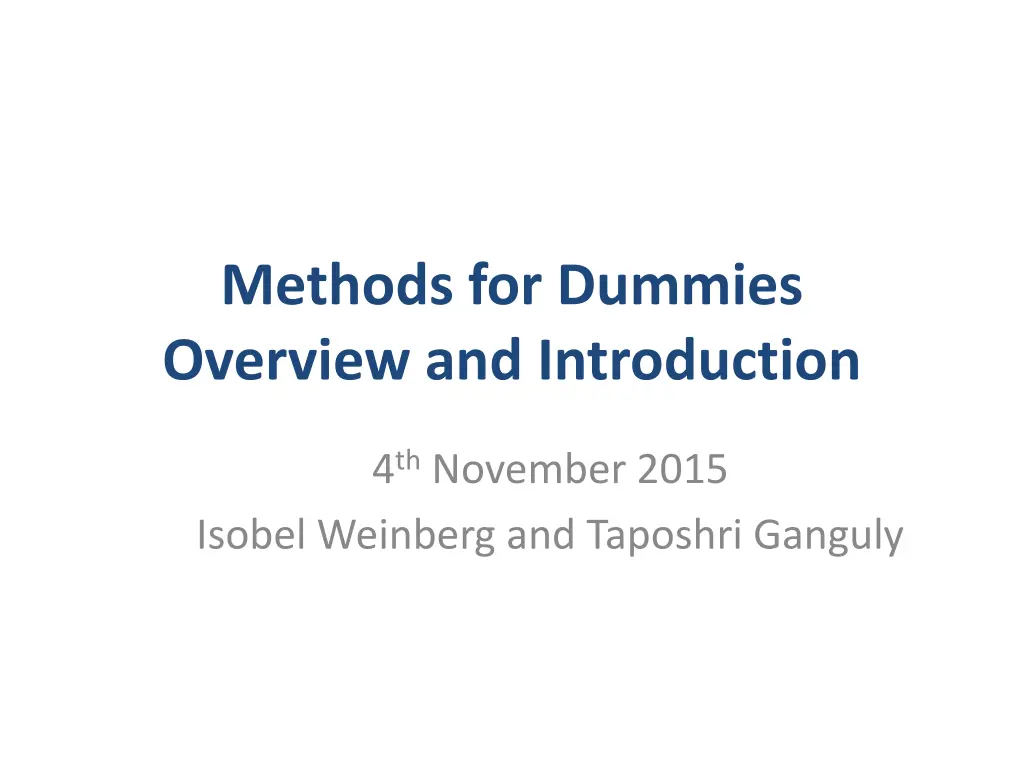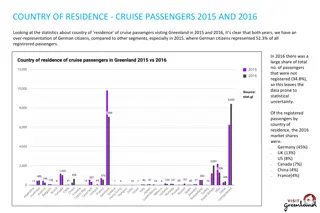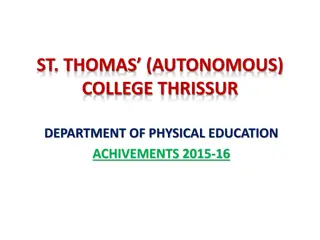
Introduction to Methods for Dummies Workshop
Explore the Methods for Dummies workshop overview and introduction, covering topics like fMRI, MEG, and EEG analysis methods. Learn about the schedule, topics, and how to prepare for presentations in this informative guide.
Download Presentation

Please find below an Image/Link to download the presentation.
The content on the website is provided AS IS for your information and personal use only. It may not be sold, licensed, or shared on other websites without obtaining consent from the author. If you encounter any issues during the download, it is possible that the publisher has removed the file from their server.
You are allowed to download the files provided on this website for personal or commercial use, subject to the condition that they are used lawfully. All files are the property of their respective owners.
The content on the website is provided AS IS for your information and personal use only. It may not be sold, licensed, or shared on other websites without obtaining consent from the author.
E N D
Presentation Transcript
Methods for Dummies Overview and Introduction 4thNovember 2015 Isobel Weinberg and Taposhri Ganguly
PROS CONS Relaxed environment Presentation skills Networking/knowing who to ask No assessment involved Fun at the FIL Know-how/practical guide Presenting with partner Learning Specific/deep understanding Overall view
Overview What is MfD? Programme How to prepare your presentation Where to find information and help Experts SPM
Welcome Aim of MfD: to provide a basic introduction to human brain imaging analysis methods, focusing on fMRI and M/EEG Wednesdays 1200-1300 hrs in 4th floor seminar room Each talk will be given by two presenters and last about 30 min + 15 minutes for questions. Generally it should introduce the relevant theory and be followed by a demo using SPM12 interface. Term 1: fMRI Term 2: MEG and EEG
Schedule 1 Introduction to MfD Basis of the BOLD signal 4/11/2015 11/11/2015 Samira Kazan Preprocessing: realigning and unwarping Preprocessing: coregistration and spatial normalization T-tests, Anovas and Regression 18/11/2015 Ged Ridgway 25/11/2015 2/12/2015 Ged Ridgway TBC 1st level analysis: design matrix, contrasts and inference, GLM 9/12/2015 Guillaume Flandin 1st level analysis: basis functions, parametric modulation and correlated regressors 16/12/2015 Guillaume Flandin 2nd level analysis: between-subject analysis 13/01/2015 Ged Ridgway
Term 2 topics 2nd level analysis: between-subject analysis Bayes for Beginners Random Field Theory Study design and efficiency Issues with analysis and interpretation (e.g. double dipping, Type I/Type II errors) Basis of the M/EEG signal Preprocessing and experimental design Contrasts, inference and source localisation Introduction to connectivity (PPI, resting state) DCM for fMRI: theory and practice DCM for ERP/ERF: theory and practice Model comparison Voxel-based morphometry Diffusion tensor imaging
How to prepare Read the Presenter s Guide http://www.fil.ion.ucl.ac.uk/mfd/page1/guide2014.pdf Remember your audience are not experts Don t just copy last year s slides isobel.weinberg.13@ucl.ac.uk t.ganguly@ucl.ac.uk
Where to find information MfD homepage: http://www.fil.ion.ucl.ac.uk/mfd/ Programme Resources: Presenter s guide, previous slides, links, SPM manual etc Name of expert (email in UCL Outlook or from typing name + FIL or UCL into Google)
Where to find information Go to the MfD homepage Resources Online Key papers Previous years slides Human Brain Function Textbook (online) SPM course slides Cambridge CBU homepage (Rik Henson s slides) Local Methods Group Experts Monday Methods Meetings (4th floor FIL, 12.30) SPM email list
Where to find help: Experts Samira Kazan Gabriel Ziegler Will Penny John Ashburner Gareth Barnes Mohamed Seghier Tom FitzGerald Guillaume Flandin Sarah Gregory Vladimir Litvak Bernadette van Wijk Dimitris Pinotsis Peter Smittenaar Email the expert: discuss presentation and other issues (1 week before talk) Expert will be present in the session
SPM Statistical Parametric Mapping Invented at the FIL A software package designed for the analysis of brain imaging data in fMRI, PET, SPECT, EEG & MEG It runs in Matlab just type SPM at the prompt and all will be revealed The SPM website has a manual and datasets available for playing around with
What does SPM and MfD do? Using neuroimaging, the idea behind SPM is to identify and make inferences about regionally specific brain activity. This gives way for analysing the integration and interactions among the engaged and identified regions. MfD helps to provide the background to understand the principles of experimental design and data analysis implemented in SPM
What does SPM do? Allows you to do: preprocessing data analysis: connectivity general linear model parameter estimation dynamic causal modeling
Preprocessing is the preparation of your imaging data to start your analysis Do motion correction (realignment of the data), normalise so that it s all in the same space, smooth the data so that you can compare between subjects.
Once you have carried out your pre-processing you can specify your design and data The design matrix is simply a mathematical description of your experiment E.g. visual stimulus on = 1 visual stimulus off = 0
GLM describes the data at each voxel: mass univariate approach It takes into account experimental and confounding effects and residual variability
Then you estimate how much your parameters of interest explain the BOLD response for each voxel, and threshold the resulting estimates to find out where your parameters explain significant amounts of variance.
Mass Mass- -univariate univariate analysis: voxel 1 analysis: voxel- -wise GLM 1 wise GLM 1 p = + y X e 2I ~ , 0 ( N ) e p e + y X = Model is specified by 1. Design matrix X 2. Assumptions about e N: number of scans p: number of regressors N N N The design matrix embodies all available knowledge about experimentally controlled factors and potential confounds.
Thank you Please don t leave without having cake






















